The Intel Xeon W Review: W-2195, W-2155, W-2123, W-2104 and W-2102 Tested
by Ian Cutress & Joe Shields on July 30, 2018 1:00 PM EST- Posted in
- CPUs
- Intel
- Xeon
- Workstation
- ECC
- Skylake-SP
- Skylake-X
- Xeon-W
- Xeon Scalable

Anyone looking at a high-end Intel system has three choices: Core i9, Xeon W, or the larger socket Xeon Scalable. Those first two both use the LGA2066 socket, and have identical core/frequency configurations, but are in effect different platforms with locked motherboards for each. The benefits of the Xeon W and Xeon Scalable lie in the ability for ECC memory, vPro management features, and with some processors there are different cache variants.
In a previous generation, Intel had workstation counterparts in line with its high-end desktop line. Both of the products used the same socket, which made it easier for consumers, and the same single socket motherboard that held a Core i7 could also run a range of Xeons: the big E7 series, the dual-socket focused E5-2600 series, and the workstation-focused E5-1600 series. The benefits of these workstation chips were primarily for ECC memory, management features, and OEM support.
Cycle forward to today, and due to socket bifurcation, none of the server focused processors will fit into a modern HEDT platform. To that extent Intel created the Xeon W family, borne from the E5-1600 line, which matches up with the consumer line but with the usual ECC/OEM add-ons. Intel also cut consumer chipset support, pushing Xeon W out of consumer hands and purely into the OEM/system market due to the lack of server chipset based motherboards at retail. Despite the doom and gloom, Supermicro recently sampled us their server chipset X11SRA and a handful of Xeon W processors for review.
The Xeon W Line-Up
Announced back in January 2018, the Xeon W launch was somewhat unexpected: we had reason to believe that Intel would introduce components for the consumer high-end desktop socket with ECC, however what form that would take was unknown, especially with processors up to 18 cores being released on the consumer side. Intel would ultimately have to draw parity with the Xeon W line, potentially causing a shift in its single socket market on the server side as well.
In the end, Intel released eight new Xeon W processors for the market, along with two off-roadmap processors for particular OEMs, and a single version for Apple. The configurations are essentially identical to the consumer HEDT line, using the Enterprise-focused Skylake-SP cores with new AVX512 instructions, a new mesh interconnect, and a rearranged cache structure focusing on L2 data. We have covered the changes compared to the standard Skylake-S core in detail in our initial Skylake-X and Skylake-SP reviews.
What Intel has done with the Xeon W processors compared to the consumer HEDT line is focus more on the lower core count models: in the full line-up there are four quad-core models, some with hyperthreading, but there are also two six-core parts, a single eight-core part, and a ten-core parts. One could interpret this SKU differentiation as Intel not focusing as much on the high-end with the Xeon W line – where the consumer line as products at 18/16/14/12/10 cores, the Xeon W only has 18/14/10/10/8 as the top five models.
| Intel Xeon-W Processors (LGA2066) | ||||||||
| Cores | Base Freq. |
Turbo 2.0 |
L3 (MB) |
L3/core (MB) |
DDR4 ECC |
TDP | Price | |
| Xeon W-2195 | 18/36 | 2.3 GHz | 4.3 GHz | 24.75 | 1.375 | 2666 | 140 W | $2553 |
| Xeon W-2175 | 14/28 | 2.5 GHz | 4.3 GHz | 19.25 | 1.375 | 2666 | 140 W | $1947 |
| Xeon W-2155 | 10/20 | 3.3 GHz | 4.5 GHz | 13.75 | 1.375 | 2666 | 140 W | $1440 |
| Xeon W-2145 | 8/16 | 3.7 GHz | 4.5 GHz | 11.00 | 1.375 | 2666 | 140 W | $1113 |
| Xeon W-2135 | 6/12 | 3.7 GHz | 4.5 GHz | 8.25 | 1.375 | 2666 | 140 W | $835 |
| Xeon W-2133 | 6/12 | 3.6 GHz | 3.9 GHz | 8.25 | 1.375 | 2666 | 140 W | $617 |
| Xeon W-2125 | 4/8 | 4.0 GHz | 4.5 GHz | 8.25 | 2.063 | 2666 | 120 W | $444 |
| Xeon W-2123 | 4/8 | 3.6 GHz | 3.9 GHz | 8.25 | 2.063 | 2666 | 120 W | $294 |
| Xeon W-2104* | 4/4 | 3.2 GHz | - | 8.25 | 2.063 | 2400 | 120 W | $255 |
| Xeon W-2102* | 4/4 | 2.9 GHz | - | 8.25 | 2.063 | 2400 | 120 W | $202 |
| *Off Roadmap | ||||||||
| Apple Only SKUs | ||||||||
| Xeon W-2191B | 18/36 | 2.3 GHz | 4.3 GHz | 24.75 | 1.375 | 2666 | ? | - |
| Xeon W-2170B | 14/28 | 2.5 GHz | 4.3 GHz | 19.25 | 1.375 | 2666 | ? | - |
| Xeon W-2150B | 10/20 | 3.0 GHz | 4.5 GHz | 13.75 | 1.375 | 2666 | ? | - |
| Xeon W-2140B | 8/16 | 3.2 GHz | 4.2 GHz | 11.00 | 1.375 | 2666 | ? | - |
One of the other changes is in the AVX512 compatibility. With the Xeon Scalable processors, each core has the equivalent of two AVX512 FMA ports on each core to maximize bandwidth, except the off-roadmap SKUs that have one. The consumer product line also has two, although Intel initially said certain parts only had one. These Xeon W parts will also have two AVX512 FMA ports each, allowing hand-tuned code to use AVX512 to its fullest. Xeon W also has ECC memory, which is usually one of the main reasons to buy the processors.
Each of the CPUs can support up to 512GB of DDR4-2400 ECC RDIMMs in a quad channel configuration, which means that each module can be 64GB apiece. This is up from the 128 GB UDIMM support on the consumer space, but lower than the 768GB RDIMM support for Xeon Scalable (caused by having six memory channels).
A small note about the ‘different’ processors in the stack. The W-2102 and W-2104 are the low-end quad-core processors without hyperthreading or Turbo, but these are classified as ‘off roadmap’. These processors are not for sale to all OEMs, like the others, and typically are built for specific OEMs that have contracts with specific customers in mind. As a result, pricing lists will not show these parts, and to be honest, Intel does not really like talking about them as promoting them has no inherent value. Of course from our perspective, we like examining every member of the stack, regardless of how widely available it is.
The other set of different processors are the Apple-only parts. These are only found in the Late 2017 model of the updated iMac Pro. Take for example the Xeon W-2150B - this 10-core processor is almost identical to the 10-core Xeon W-2155, but has a lower base frequency of 3.0 GHz (compared to 3.5 GHz). The lower base frequency will greatly reduce the TDP of the processor, however these processors rarely run at base frequency and almost always in a turbo state, where TDP is undefined, making it difficult to place this processor. It is most likely a part that is binned well for voltage, frequency, and power. Again, this is another part that isn’t available to everyone (but if someone has one, we’d love to test it).
All these processors will require a motherboard that uses the C422 chipset. These chipsets are almost identical to the X299 chipsets used in the consumer platform, but are firmware locked to Xeon W processors only with support for ECC. Because of the split between the consumer and workstation platforms, there are very few C422motherboards in the open market for custom builders – most OEMs (Dell, Supermicro) build their own internal motherboards for pre-built systems specifically for their own customers, and optimized for their intended outcome (performance, price, etc.).
Per Core Turbo Data
Intel's per-core turbo data for these workstation parts are split up into three sections, due to the instruction sets they have. On the 'hardest' instructions, Intel uses special turbo values for AVX-512, as due to the way these instructions are processed, more heat is generated on chip. The chip has to balance frequency and power draw, so the AVX-512 data comes in at a lower frequency in order to keep the turbo in check.
The first thing to notice with this data is that for most CPUs, when the whole CPU is using AVX-512 instructions, the frequency will drop below the base frequency. For chips like the Xeon W-2123 and W-2133, even single core loading of AVX-512 will drop the frequency below the base frequency. Intel's base frequency does two things: first, it tells you the frequency at which TDP is applicable, and second it is the guaranteed minimum frequency for regular non-AVX instructions.
Behind AVX-512 is AVX2, which is still somewhat of a strain on the processor beyond regular instructions, but not as much. Where AVX-512 requires dedicated die area for support of the vector units, AVX2 is built into the back-end of the standard core design.
For AVX2, the W-2133 and W-2123 still end up below the base frequency of the processor. But for the big ones, like the W-2195, the full 18-core loading of AVX2 is 500 MHz faster than AVX-512. This is just an indication that users that are fine-tuning code should think about how much of the AVX-512 unit they can keep fed - the AVX-512 unit despite the 500 MHz difference is expected to be faster no doubt, but a half-fed AVX-512 might get trumped by a full AVX2.
For the regular instructions, turbo goes a bit like this:
For a number of users, the key metrics here are the all-core turbos, with the 18-core part having an all-core turbo of 3.2 GHz. Interestingly the W-2155 and W-2145 sits well here: for any code that can't reliably go beyond 12-14 threads, having the higher frequency but lower core count part might actually perform better. We saw a bit of this in our review, with the variable threaded loads executing somewhat better on the W-2155 than the W-2195.
Then and Now: Defining a Workstation
By splitting the motherboard support for workstation grade processors, Intel has (whether on purpose or not) redefined what it means to have an Intel workstation. In previous generations, a certain market of users would happily invest into an E5-2640 style processor and place it into a single socket consumer motherboard, taking advantage of a potentially better-binned processor, and on some motherboards that qualified it, ECC memory. Depending on the location and time, in some instances this method was cheaper than going for the similar grade consumer processor. Due to the motherboard support, these systems were certainly more widespread compared to today. In fact, some users are currently looking to eBay and investing in older 8-core and 10-core processors because they are extremely affordable.
In 2018, for the Intel workstation enthusiast, the situation is complicated and confusing.
If a workstation user looked at consumer-grade hardware, they can get the cores and the motherboard, but lose the ECC memory and co-processor compatibility consummate with a professional system: some motherboard hardware may not be qualified with Quadro, Tesla, FirePro, Xilinx, Altera, etc., because those motherboards aren’t built for that market.
If a workstation user looked at professional-grade hardware, it becomes a case of struggling to self-build based on availability or paying through the nose for an OEM system that might have some horrendous markup. We spoke to one OEM in years past, who said that the prices on the website were almost fictitious – most of their sales in this area come from large-scale corporate contracts which offer discounts based on volume. The single home-brew workstation user was not their target market, unless they wanted to pay the high prices.
| Similar SKU Comparison | |||
| Features | Skylake-X (i9-7980XE) |
Xeon-W (Xeon W-2195) |
Skylake-SP (Xeon 6140/M) |
| Platform | X299 | C422 | C620 |
| Socket | LGA2066 | LGA2066 | LGA3647 |
| Cores/Threads | 18 / 36 | 18 / 36 | 18 / 36 |
| Top Base/Turbo | 2.6 / 4.2 | 2.3 / 4.3 | 2.3 / 3.7 |
| GPU PCIe 3.0 | 44 | 48 | 48 |
| DRAM / DDR4 | 128GB UDIMM Quad-Channel |
512GB RDIMM+LRDIMM Quad Channel |
768GB / 1536GB RDIMM+LRDIMM Six Channel |
| 512-bit FMAs | 2 | 2 | 2 |
| Max Sockets | 1 | 1 | 4 |
| TDP | 165W | 140W | 140W |
| Price | $1999 | $2553 | $2451 / $5448 |
Ultimately if a user is going above and beyond for an OEM system, it might be worth looking into Xeon Scalable processors, especially if multiple sockets in a single system are required. This increases the expense significantly, however. The benefits on building a consumer-based workstation, if memory is not needed, also come down to clock speed and AVX-512 support.
The alternative is to look at AMD’s workstation offering, Threadripper, which is cheaper, offers similar core counts, more ECC memory per processor (depending on motherboard support), and more PCIe lanes, but does not have AVX-512 and can suffer from a non-unified memory architecture for software that requires a lot of core-to-core and core-to-memory communication. The multi-socket option here is EPYC, which gets more cores and more system memory, but not increase in PCIe lanes due to the way the platform shares resources.
| Intel vs AMD Comparison | |||
| Features | Xeon-W Xeon W-2145 |
AMD Ryzen TR 1900X |
AMD EPYC 7401P |
| Platform | C422 | X399 | - |
| Socket | LGA2066 | TR4 | SP3r2 |
| Cores/Threads | 8 / 16 | 8 / 16 | 24 / 48 |
| Base/Turbo | 3.7 / 4.5 | 3.8 / 4.0 | 2.0 / 3.0 |
| GPU PCIe 3.0 | 48 | 60 | 124 |
| DRAM / DDR4 | 512GB RDIMM+LRDIMM Four Channel |
128GB UDIMM Four Channel |
2 TB RDIMM+LRDIMM Eight Channel |
| AVX-512 | 2 FMA | - | - |
| L3 Cache | 11 MB | 32 MB | 64 MB |
| TDP | 140W | 180W | 170W |
| Price | $1113 | $549 | $1075 |
A lot of purchasing decisions will be skewed specifically for the workflow in mind, which is one of the reasons why we have so many benchmarks in play for our reviews – there is no ‘one benchmark fits all’ scenario, and we are now in a situation where there are multiple options to choose from depending on the size of the wallet.
This Review
For our analysis today, we were able to secure five of the Xeon W processors: the top-end 18-core W-2195, the mid-range ten core W-2155, the more budget quad-core W-2153, and the two off-roadmap processors in the W-2104 and W-2102.
We have put these processors through our current generation testing suite, with the Spectre and Meltdown patches applied. The main targets for comparison are Intel’s Skylake-X high-end desktop platform, Intel’s Skylake-S consumer platform, and AMD’s Ryzen and Threadripper platforms.
The motherboard used in our review is the Supermicro X11SRA, one of the more 'available' Xeon W motherboards on the market.
You can read our review of the motherboard here.
We must also say thank you to Kingston for sampling us some DDR4-2666 C19 RDIMM Memory for this review.
Xeon W processors support RDIMM ECC memory, and our motherboard here would not accept UDIMMs, and Kingston kindly supplied the memory needed. The (KSM26RS8/8HAI) modules were faultless in our testing.
Pages In This Review
- Overview of Xeon W
- Test Setup and Power Consumption
- CPU Benchmarking: Office Tests
- CPU Benchmarking: System Tests
- CPU Benchmarking: Rendering Tests
- CPU Benchmarking: Encoding Tests
- CPU Benchmarking: Web Tests
- CPU Benchmarking: Legacy Tests
- Spectre vs Meltdown: SYSMark
- Conclusions: Is Intel Serious About Xeon W?


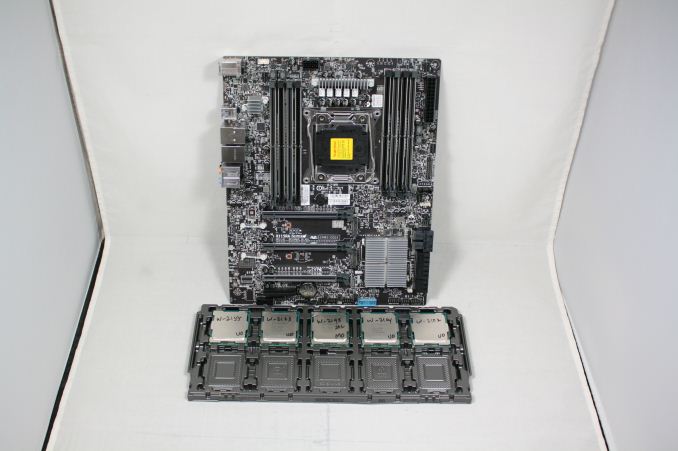
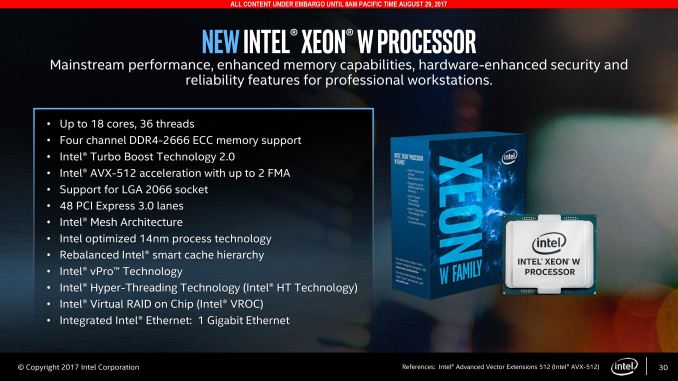
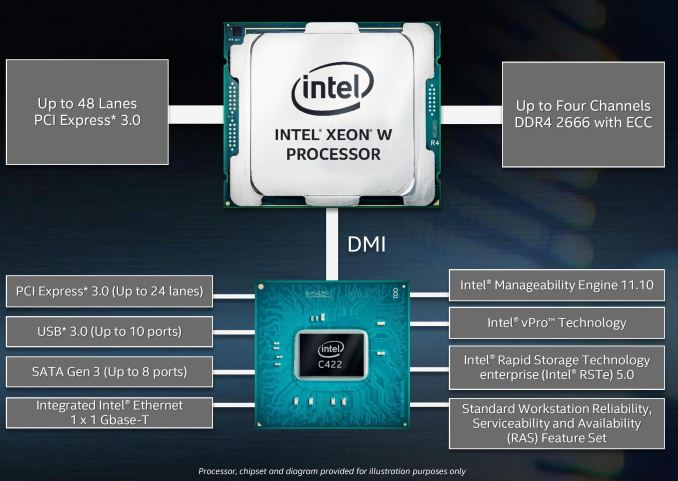



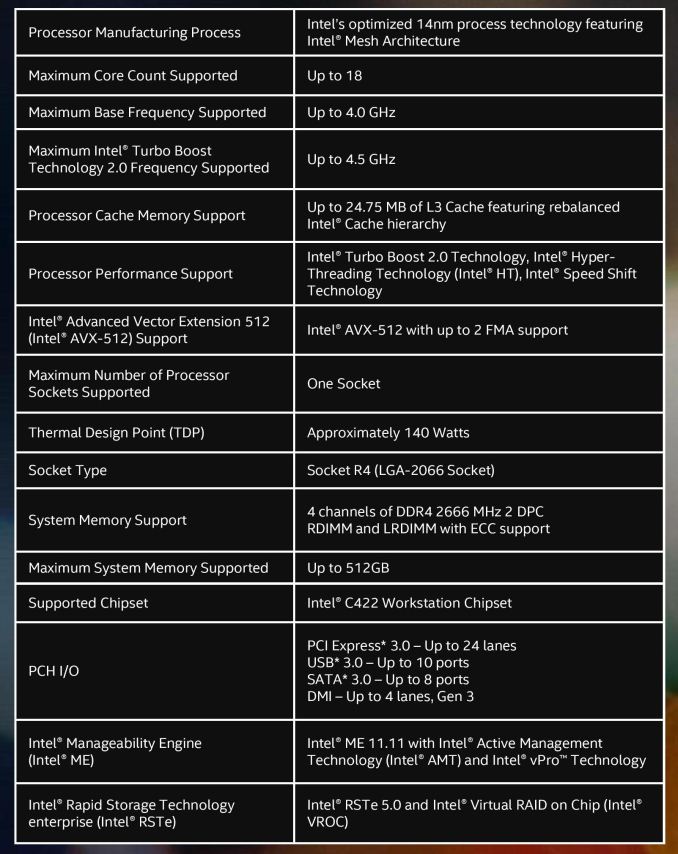
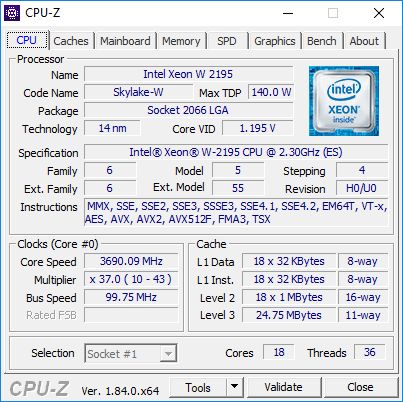



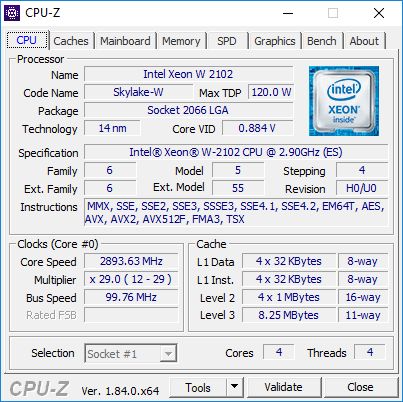
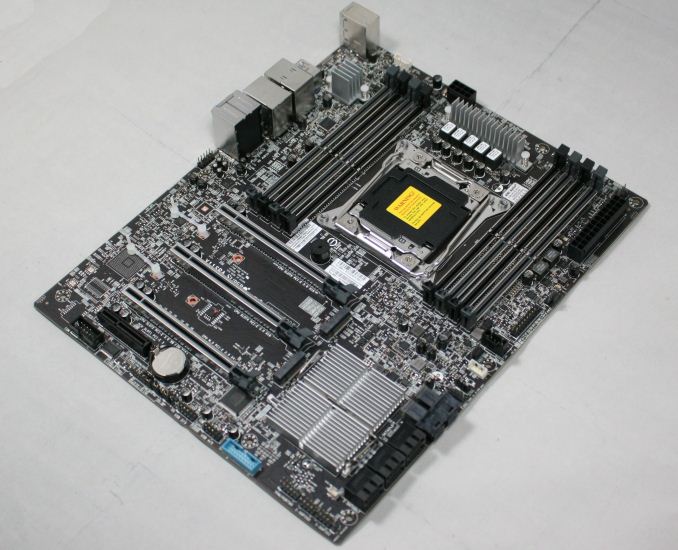
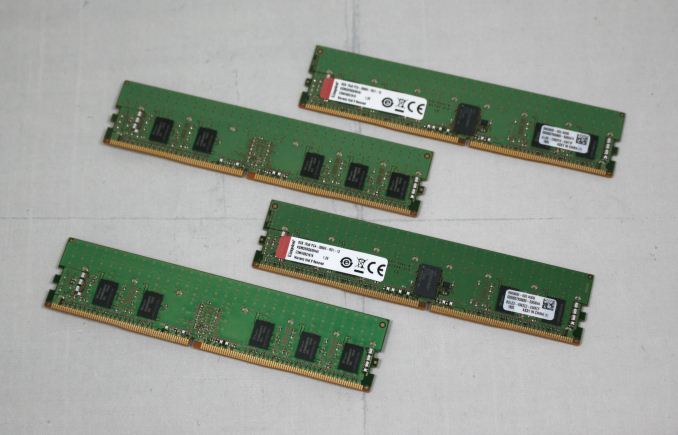








74 Comments
View All Comments
Ian Cutress - Monday, July 30, 2018 - link
If we ever get a Xeon Scalable system up and running for proper benchmarking, I'll run through some tests.JoJ - Saturday, August 4, 2018 - link
Hi Ian,I beg you to consider the futility of approaching HPE, to obtain a Z station and 56 Scalable cores, max RAM etc, may not may be wholly as anticipated.
I have a very high profile media production job coming, that could warrant a room of fully loaded such machines. Truly high profile. I have been always able to establish nearly immediate rapport with the marketing folk who are not apparently thought about by the UK online tech media, as warmly as I think it fair, but then I deal in printed worlds of very controlled readerships, and possibly by reflex alone I'm treated like I have more to say than I often do. But approaching the twenty five years mark, I probably ran out of lines some nineteen years ago anyway...
I care about hurling around heavily laden InDesign files, often without any media placeholders to include 409MB Hassleblad captures straight from the photographer. This project is going to be filled with custom adverts not run in any other media ever. (It took longer to agree copy for Rolls Royce than to sell the deal, in our first encounter with this project. VWAG owned both marques including Bentley, then.) Advertisers may visit, our job to produce for them their first display copy ever, because of interest from services who are in the word of mouth referral ecosystem this publication represents. We are effectively building a advertising studio, to accommodate the needs presented by, eg a long established security company, beyond public profile not by necessity or plan but rather not seeing the circle squared to deliver satisfactory result, without establishing unwanted capacity or staffing. So founder directors shall descend, for interview and portrait, the deal being approved by them signing a proof of the pages, in person, ideally we are able to complete 60% of the interview and layout remotely in advance.
I want to suggest to you that HPE could genuinely be intrigued by the client base of our project, and want to be exposed to them... mostly boutique banks and funds. A typical user is running a dozen Bloomberg Professional windows, Excel, with live updates and a lot of libraries for giving cell results, will have a terabyte or so of core textual references, between academic papers, email threads, online discussion (usually scraped) , and the job is to fill very specialist magazines with content and advertisers who don't play in the spray and pray brand game, but care everything about how they're found by a prospective new customer. So atop the trappings of a financial trader's desktop, will be layered Word, sure, but a TeX compositor, Visual studio, InDesign, PS...WHY? Because if we can get the message right, we can trade quickly to fill a matching campaign of the same redundancy as big ad buyers get, at even sharper prices. They come for creative, stay for flow execution.
It's realistic, even commonplace, for a Xeon Scalable workstation to find itself in front of board member powers, in this way.
Looking at the decisive commitment required to purchase current generation high end workstations, I assume that HPE, Dell et.al. just lean on their direct sales forces.
but strip away our Corporate veneer, and we're indistinguishable from any of your readers.
Individual buyers of workstation class computers, commonly inhabit the front line trenches of high end media production. London seethes with freelancer artists, driven by insufficient investment by employers, to fly solo simply to stay current with the tools and turnaround of their art. I can't win any argument about how far from the public imagination of the game, is the typical MB Pro user, sat elegantly in a WeWork chair, I thought my first sight of the Barbican WeWork office, was a film set... (whereas we're actually building a film set where to conduct our FOH business, because I can't vouch for the appearance of our actual digs. (Mr CIO left of his own accord, incapable of tolerating our disinterested views of fancy workspaces... the fact that our dev team is 80% founder level partner, actually never came into play, but the non attendance at his"corporate development" meetings, was protest against the idea of competing for hires with luxuries. Pity, in this one respect alone, the one character aspect we didn't believe necessary to investigate in interview, so patent is our third world architectural infrastructure, relations truly soured only because the guy was so good in every way otherwise. We just couldn't please with such capital commitments, not looking at the impending A grade glut just completing in the City. Such dangerous words; "absolutely, in the future, if you take us there, we will want a statement head office for sales etc". Just not on any immediate plans..
sorry, Ian, I am avoiding saying that I think I certainly could sell a HPE on the facts we know very well, where they'll be getting sales, in this sector at least, more from physical exposure to buyers and influencers, directly demonstrated the new generation capability by entirely non conveniently situated independent professionals and outside service companies, but absolutely nothing to look at in the kind of performance review I can't really understand is so homogeneous online, because this sort of evaluation hardly relates to the real use at all.
I am adamant that the entire presentation of high end desktop bixes is hostile and increasingly damaging to sales of performance workstations to corporate office buyers of all kinds.
Wall to wall gamer imagery has diluted the public perception of utilitarian power of computers beyond homeopathic insignificance.
Nothing, not a single word for twenty years- it seems to me - has conveyed any part of this crucial message: "With this new Intel computer, and the latest developments in the most advanced quantitative tools for generations, I WHOOP MY COMPETITIONS REAR!'
By all means, running a renderer matters in the industry that we inhabit. But the reason why we'll shell out for a 56 core beast, is so we can quickly previs a scene, while still working through the latest circulation data dump for the 200,000 or so publications we trade advertising on. Most days, we're rendering visuals of the data we don't want to take our concentration aeay from, again the reason why we're looking at the new HPE Z station Scalable workstations.
i have to be distracted but I'll conclude with guaranteed brevity upon my short return. There's plenty of angles here to get a vendor to cough up a couple of fully loaded machines for you, and I am entirely serious I'll invest the necessary time to get you a shot if you think I'm not batshii crazy. bfn
Elstar - Monday, July 30, 2018 - link
To be fair, the top end Core X and Xeon W have different TDP values.HStewart - Monday, July 30, 2018 - link
So does TDP values make bigger impact than actual Frequency - on same chip of course.BurntMyBacon - Tuesday, July 31, 2018 - link
It is more that TDP and frequency can no longer be separated. If you completely ignore TDP and fix the frequencies to their maximum, then TDP only matters in as much as you have the proper cooling solution to manage it. However, the actual running frequency of Intel's processors are tied into processor temperature, power, number of active cores, etc. On the same chip, a larger TDP means the processor can spend more time at higher frequencies or have more cores active at the same frequency.mode_13h - Monday, July 30, 2018 - link
The difference relative to X-series is probably due to thermal throttling due to dual AVX-512 and heat buildup under the non-soldered IHS.HStewart - Monday, July 30, 2018 - link
That would also be interesting test - I believe AVX-512 can be turned off in bios - not sure since I don't have one.JlHADJOE - Tuesday, July 31, 2018 - link
Lack of Turbo Boost 3.0 maybe?stanleyipkiss - Monday, July 30, 2018 - link
Besides the VM situation on Threadripper, why would anyone spend $2500+ for this?duploxxx - Monday, July 30, 2018 - link
what VM situation?